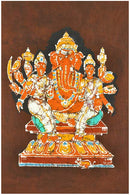Specification
- Product Code :4199
- Material :Cotton Cloth
- Size :27"h x 18"w
Description
The beautiful Batik painting depicts the Lord of Wisdom in a most refine manner with a deep sense of finesse. Here the Lord is painted in a seated posture. One of the most powerful gods in Hindusim, Lord Ganesha is worshipped first among all gods and is there known as Agra Ganya. The Lord is also known as the Remover of Obstacles as he removes obstacles from our path. Batik is a very ancient art of making paintings using wax. The technique of Batik is a rigorous one as the final design must be conceived before the painting is begun. The batik painter works intimately with colour pattern; if he wants parts of his design to blue, for example, all these parts must be waxed at the same time before any subsequent dyeing. He cannot separate one part of his design and complete it before moving on to the others as an artist in oils or watercolor may; he must create his design in stages, each of which encompasses the whole picture. The selection of waxes is important to the quality of the finished batik. Paraffin and beeswax are the two waxes most commonly used in batik and are usually combined in different proportions.
Description
Specification
- Product Code :4199
- Material :Cotton Cloth
- Size :27"h x 18"w
Description
The beautiful Batik painting depicts the Lord of Wisdom in a most refine manner with a deep sense of finesse. Here the Lord is painted in a seated posture. One of the most powerful gods in Hindusim, Lord Ganesha is worshipped first among all gods and is there known as Agra Ganya. The Lord is also known as the Remover of Obstacles as he removes obstacles from our path. Batik is a very ancient art of making paintings using wax. The technique of Batik is a rigorous one as the final design must be conceived before the painting is begun. The batik painter works intimately with colour pattern; if he wants parts of his design to blue, for example, all these parts must be waxed at the same time before any subsequent dyeing. He cannot separate one part of his design and complete it before moving on to the others as an artist in oils or watercolor may; he must create his design in stages, each of which encompasses the whole picture. The selection of waxes is important to the quality of the finished batik. Paraffin and beeswax are the two waxes most commonly used in batik and are usually combined in different proportions.
Payment & Security
Your payment information is processed securely. We do not store credit card details nor have access to your credit card information.


